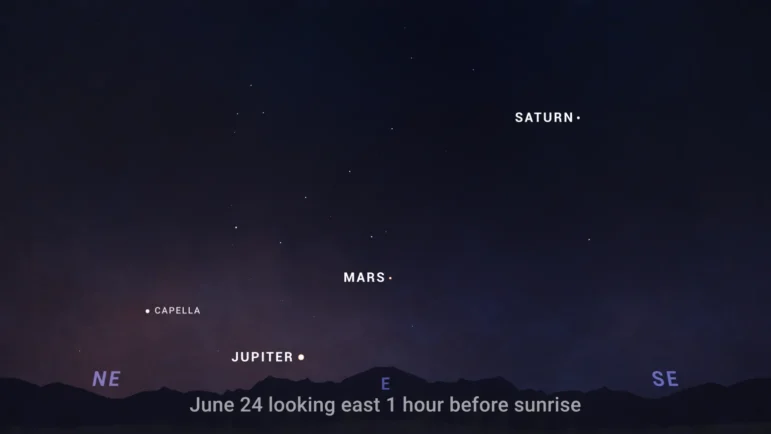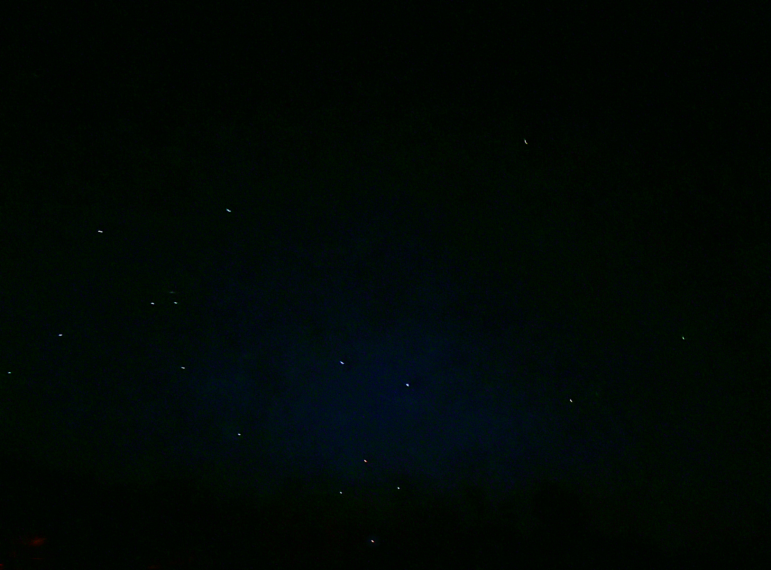
TWH – After the rare celestial events of April’s solar eclipse and last month’s outstanding display of the auroras, 2024 is shaping up to be an extraordinary year for night sky viewing and rare astronomical and astrological events.
June 2024 should be no different. The month is serving up some amazing views and a rare alignment of planets.
“All the planetary action continues in the morning sky,” NASA wrote, “with Saturn and Mars rising in the early morning hours. They are joined later in the month by Jupiter.”
Beginning tonight, Mars will re-appear in the sky towards the east in the early morning near the crescent moon. We’re told that Saturn will be “lurking nearby, toward the south.” Tomorrow night, Mars’s red reflected light will be brightly visible underneath the waning crescent moon in the morning twilight.

“Sky chart showing the planets’ Saturn, Mars, and Jupiter forming a diagonal line across the morning sky in late June”. Courtesy of NASA/JPL-Caltech
The night of June 5 is the dark of the moon, and the new moon will appear on June 6.
The June solstice, which is Litha or Midsummer in the northern hemisphere and Yule or Midwinter in the southern hemisphere, will occur on Thursday, June 20, 2024, at 4:51 PM EDT (20:51 UTC) and, this year, also heralds the arrival of the full moon on the following day.
The June full moon is often called the Strawberry Moon. This name originates from Native American Algonquin tribes, who used it to mark the time of year when wild strawberries were ripe for picking. In parts of Europe, the June full moon is called the Rose Moon, which reflects the blooming of roses during this time of year. Like the Strawberry Moon, the Rose Moon marks a period in the early summer when certain natural events, such as the flowering of roses, are prominent.
In some cultures, the June full moon is called the Honey Moon. While June is the most popular month for marriages in Western cultures, the name actually refers to the first honey harvest now available after the spring flow.
In medieval Europe, newlyweds were often given a moon’s cycle (about 30 days) worth of mead by their families. This practice was believed to promote fertility and ensure happiness and prosperity in their marriage. In Norse culture, the “hjunottsmanathr” was used to describe the honeymoon. This period was a time when newlyweds drank a special fermented honey wine during the first month of their marriage to improve the likelihood of conception and to ensure a prosperous and happy union.
If you live in the “little latitudes” of the northern hemisphere, the constellation Crux, commonly called the Southern Cross, is visible just above the southern horizon, usually after astronomical twilight, the period after sunset when the sky’s illumination is so faint that most casual observers would consider it fully dark, particularly in areas with urban or suburban light pollution.

The Southern Cross viewed just south of TWH HQ – MJTM
On June 24, Jupiter will become visible low in the eastern sky before sunrise. During the last week of June, look for the bright planet above the horizon. It will form a line with Mars and Saturn stretching toward the south.
June 24, by the way, is celebrated in Catholicism and other denominations of Western Christianity, as The Nativity of John the Baptist. St. John’s Eve is marked as time when witches and demons are allowed to run around. In Cuba, Puerto Rico, and other parts of the Caribbean and Latin America, St. John’s even is celebrated much like Halloween is in the Anglosphere. It is also a time of gathering herbs and dew to create potions.
In Italian folk magic and Witchcraft, the night is one for oomancy, using eggs for divination. An egg is dropped into a glass of water on St. John’s Eve and the following morning, the shape and spread of the egg whites can be read by an expert.
More on that later this month, but now back to the skies…
Some online sources have expressed excitement about a “parade of planets” visible in the morning sky in early June, particularly on June 3.
NASA, unfortunately, said no.
In reality, only two of the six planets supposedly on display (Saturn and Mars) will actually be visible. During this period, Jupiter and Mercury will be at or below the horizon in the morning twilight and therefore not visible. The closest thing to a planet parade will occur on June 29, when Saturn, the Moon, Mars, and Jupiter will line up across the morning sky. Uranus and Neptune will be present, but the morning glow of the sun will limit viewing and they may not be visible without a telescope or a good set of binoculars.
One last thing to mention, that massive sunspot that delivered the auroras last month has now made its trip around the sun and is aimed towards Earth again. It may mean more solar weather and stunning views in the night sky.
The Wild Hunt is not responsible for links to external content.
To join a conversation on this post:
Visit our The Wild Hunt subreddit! Point your favorite browser to https://www.reddit.com/r/The_Wild_Hunt_News/, then click “JOIN”. Make sure to click the bell, too, to be notified of new articles posted to our subreddit.